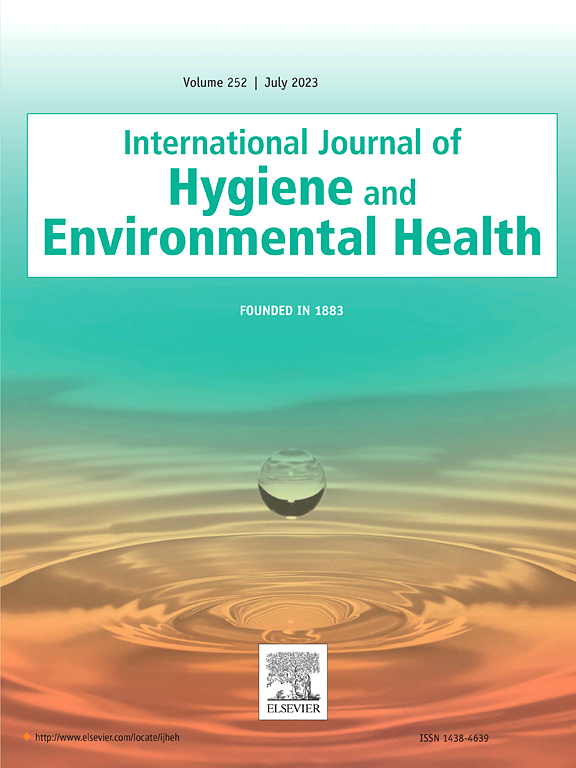Prevalence of antibiotic-resistant enterobacteriaceae in domestic wastewater and associated health risks in reuse practices
IF 4.5
2区 医学
Q1 INFECTIOUS DISEASES
International journal of hygiene and environmental health
Pub Date : 2024-10-05
DOI:10.1016/j.ijheh.2024.114478
引用次数: 0
Abstract
The use of wastewater for non-potable purposes is an important alternative for addressing water scarcity, especially in developing regions. However, minimizing the risks, particularly those associated with emerging contaminants that may induce resistance among pathogens in wastewater, is crucial. This study assessed the occurrence of antibiotic-resistant bacteria in untreated wastewater used for agricultural purposes and evaluated the quantifiable health risks associated with this practice in Tamale, Ghana. The resistance of some Enterobacteriaceae, such as E. coli, Klebsiella, and Salmonella-Shigella, to four commonly used antibiotics in Ghana was assessed using a conventional microbiological culture approach and the Kirby Bauer disk diffusion method. A Quantitative Microbial Risk Assessment (QMRA) was performed to estimate the health risks associated with two distinct scenarios of wastewater reuse: (1) accidental ingestion of contaminated wastewater and soil, and (2) consumption of vegetables irrigated with wastewater. This approach applied a Monte Carlo simulation based on 10,000 interactions and identified E. coli O157:H7 as the reference pathogen. Among Enterobacteriaceae, Klebsiella pneumoniae, Salmonella-Shigella and E. coli were isolated, in concentrations exceeding the limit recommended by the World Health Organization (103 CFU/100 ml). All the isolated bacteria were resistant to metronidazole (5 μg). Thirty-three per cent of Klebsiella pneumoniae isolates were intermediate/moderately susceptible, and all other bacteria were resistant to amoxicillin (30 μg). All Klebsiella pneumoniae and the majority of Salmonella-Shigella (69.8 %) isolates were resistant to trimethoprim-sulfamethoxazole (25 μg) and tetracycline (30 μg). When assessing health risks, the mean annual probability of infection associated with consuming vegetables irrigated with wastewater varied between 5.14 × 10−2 and 9.79 × 10−1 per person per year. Conversely, for the accidental ingestion scenario, the probability was 1.00 per person per year. In these scenarios, the probability of illness ranged from 1.29 × 10−2 to 2.4 × 10−1 and 2.5 × 10−1 per person per year. The health risks posed by these findings surpass the maximum threshold prescribed by the World Health Organization, thereby emphasizing the need for prompt mitigation strategies.
生活废水中抗生素耐药肠杆菌科细菌的流行以及再利用实践中的相关健康风险。
将废水用于非饮用水用途是解决水资源短缺问题的一个重要选择,尤其是在发展中地区。然而,最大限度地降低风险,尤其是与废水中可能诱导病原体产生抗药性的新兴污染物相关的风险,是至关重要的。本研究评估了加纳塔马利未经处理的农业废水中抗生素耐药细菌的发生情况,并评估了与这种做法相关的可量化健康风险。采用传统微生物培养法和柯比鲍尔盘扩散法评估了加纳一些肠杆菌科细菌(如大肠杆菌、克雷伯氏菌和沙门氏菌-志贺氏菌)对四种常用抗生素的耐药性。进行了微生物定量风险评估 (QMRA),以估计与废水再利用的两种不同情况有关的健康风险:(1) 意外摄入受污染的废水和土壤,以及 (2) 食用用废水灌溉的蔬菜。该方法采用基于 10,000 次相互作用的蒙特卡罗模拟,并确定大肠杆菌 O157:H7 为参考病原体。在肠杆菌科细菌中,分离出了肺炎克雷伯菌、沙门氏菌-志贺氏菌和大肠杆菌,其浓度超过了世界卫生组织建议的限值(103 CFU/100 ml)。所有分离出的细菌都对甲硝唑(5 微克)有抗药性。33% 的肺炎克雷伯氏菌对阿莫西林(30 微克)具有中等/中度敏感性,其他细菌对阿莫西林均有抗药性。所有肺炎克雷伯氏菌和大多数沙门氏菌-志贺氏菌(69.8%)对三甲双氨-磺胺甲噁唑(25 微克)和四环素(30 微克)有抗药性。在评估健康风险时,与食用用废水灌溉的蔬菜有关的年平均感染概率介于每人每年 5.14 × 10-2 和 9.79 × 10-1 之间。相反,在误食情况下,每人每年的感染概率为 1.00。在这些情况下,每人每年患病的概率介于 1.29 × 10-2 到 2.4 × 10-1 和 2.5 × 10-1 之间。这些发现对健康造成的风险超过了世界卫生组织规定的最大阈值,因此强调有必要采取及时的缓解战略。
本文章由计算机程序翻译,如有差异,请以英文原文为准。
求助全文
约1分钟内获得全文
求助全文
来源期刊
CiteScore
11.50
自引率
5.00%
发文量
151
审稿时长
22 days
期刊介绍:
The International Journal of Hygiene and Environmental Health serves as a multidisciplinary forum for original reports on exposure assessment and the reactions to and consequences of human exposure to the biological, chemical, and physical environment. Research reports, short communications, reviews, scientific comments, technical notes, and editorials will be peer-reviewed before acceptance for publication. Priority will be given to articles on epidemiological aspects of environmental toxicology, health risk assessments, susceptible (sub) populations, sanitation and clean water, human biomonitoring, environmental medicine, and public health aspects of exposure-related outcomes.

 求助内容:
求助内容: 应助结果提醒方式:
应助结果提醒方式:


